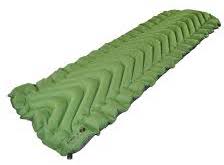Improvised Splints
This post is about improvised splints that you can make with some camping equipment you probably already have. You could carry a Sam splint with you into the backcountry, but you can make a splint that is just as good or better with stuff you already have. A lot of Scouts have the ubiquitous blue closed cell foam sleeping pad. You can fashion these into splints. Unless you are splinting an entire leg, you are probably going to have to cut the foam. Consider that these mats cost a few bucks less than a SAM splint. Although the SAM splint is reusable, once you send somebody to the hospital with your SAM splint, you will probably never see that splint again. Just sacrifice the mat, and buy a new one later.
Below are splints for the forearm and lower leg made from a cut closed cell foam pad.Splints can be secured with a variety of items. Neckerchiefs, bandanas, belts, sleeping bag straps or duct tape. If you have a belt that is infinitely adjustable, like a Scout uniform belt or rigger belt, you will have a lot more options than your typical leather belt. You can roll duct tape around trekking poles, canoe/kayak paddles, external pack frames, or around an old credit card. Always have about 10 feet of duct tape available.
Inflatable sleeping mats (not self-inflating) can be used to make a very good splint, and you don't have to harm the mat in the process. That's a good thing, because they can be expensive. They can be folded to fit and strapped down before you inflate them. Once inflated, they are form fitting and work very well.
There are also inflatable seat pads that can be used for smaller (forearm/wrist) splints.
Below is a knee immobilizer for a sprained knee. You can still walk with this on if you have to. By not leaving space between the bottom of the splint and the top of the shoe, this splint will not slide down the leg while walking. Put the air valve down by the foot end.
Below is a splint for a broken ankle. You can't walk on this one.
Below is a splint for a broken wrist or forearm make from an inflatable seat pad. Use this in conjunction with a sling.
I still carry a SAM splint, because you can use it to make a cervical collar for a neck injury. It can also be used to make an arm or leg splint, but I like the inflatable splint better. If you have a patient with multiple injuries and only one or none SAM splints, you will be glad you learned to improvise.











Comments
Post a Comment